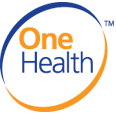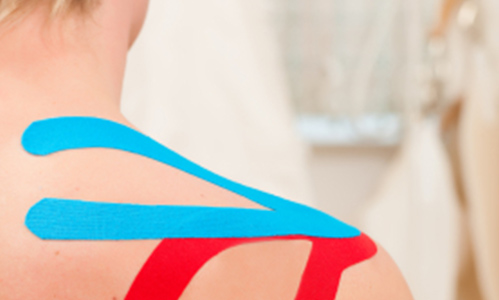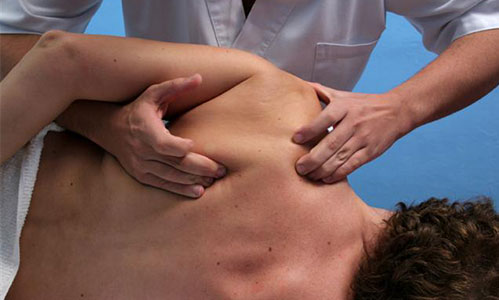What we treat
We treat all areas of the body. Please click on the categories below for comprehensive list of conditions:
- Neck and Upper back
- Shoulder and Upper Arm
- Elbow, Forearm, Wrist and Hand
- Low Back (Lumbar Spine)
- Hip, Pelvis and Upper Leg
- Knee and Lower Leg
- Ankle and Foot
- Sports Injuries
At The Physio Clinic a combination of treatments are used to achieve your optimum recovery.
We use a variety of 'hands on' manipulative techniques which may be gentle or more vigorous depending on the individual situation. These techniques reduce pain, restore joint movement and help improve muscle function and nerve mobility. This may be combined with soft tissue techniques which have many benefits including easing tight muscles and reduction of scar tissue. This will help reduce pain and aid the healing process.
Manual therapy techniques may be supplemented by electrotherapy, such as ultrasound, interferential, TNS and megapulse which relieve pain, reduce inflammation, and enhance the healing process.
Most patients will also be given a specific exercise program tailored to their individual needs. This will support the treatment given and facilitate return to activity as soon as possible
The Neck and Upper Back
The neck (or cervical spine) is a highly complex structure which supports the head and allows extensive range of movement. It is vulnerable to injury and wear and tear problems, making it one of the most common conditions we treat. It can also be the origin of head pain and headaches.
It is composed of seven bones, (vertebrae), which are numbered from the base of the skull downwards, C1-C7. The upper two are a different shape to the others, allowing for extensive rotational movement.
The vertebrae are peculiarly shaped bones which are linked to their adjacent vertebrae by small joints (called facet joints). There is a 'disc' situated between each vertebrae which has a soft gel-like centre surrounded by a tough fibrous outer layer. The disc acts like a 'shock absorber' and helps give the neck its great flexibility.
The spinal cord is protected within the vertebrae. There are branches, (nerve roots), coming off the spinal cord between each vertebrae and going down the arms.
The upper back (or thoracic spine) is similar in design the neck but with 12 vertebrae, also with a disc in between them. The vertebrae are numbered T1-T12 and are slightly different in shape and have a rib attachment resulting in greater stability but reduced flexibility.
Neck and upper back conditions that we treat
- Neck related headaches
- Stiff, painful neck
- Disc conditions (bulging/slipped/degenerative/ruptured discs)
- Trapped nerves and referred arm/hand pain from the neck
- Whiplash injuries
- Arthritis/cervical spondylosis
- Wry neck (Torticollis)
- Postural/stress related neck pain
- Costochondritis (breastbone and rib cartilage pain)
- Kyphon Balloon Kyphoplasty
- Fractures (broken bones)
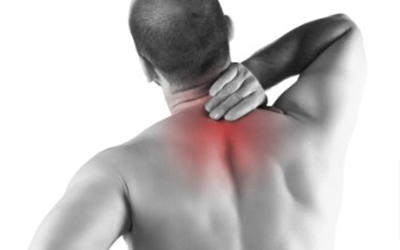
Following surgery
- Spinal decompression
- Anterior cervical discectomy with fusion
- Cervical laminectomy
- Injections (nerve root blocks/facet joint)
This list is not exhaustive; please ring the clinic if you have any queries about other conditions or injuries.
Your condition will be thoroughly assessed by your physiotherapist, who will explain their findings and discuss the proposed treatment plan with you for your agreement.
When treating neck problems it is particularly important to try and address the cause of the problem to try to prevent reoccurrence. You may also benefit from our individual Pilates sessions to improve core strength and posture.
For extra information or to book an appointment please call 0114 237 3006 or email info@thephysioclinic.org
The Shoulder and Upper Arm
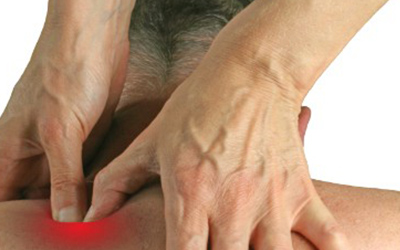 The shoulder is the most flexible joint in the body. It is able to undertake a tremendous range of movement combined with great power. In order to achieve this combination it has a complex design which not only provides movement but also the required stability.
The shoulder is the most flexible joint in the body. It is able to undertake a tremendous range of movement combined with great power. In order to achieve this combination it has a complex design which not only provides movement but also the required stability.
It is made up of 3 main bones, the humerus (upper arm), shoulder blade, (or scapula) and collarbone (or clavicle).
Four joints make up the shoulder 'complex'. The main shoulder joint is a ball-and-socket joint, (called the glenohumeral joint), which is where most of the shoulder movement occurs.
There is a rotator cuff consisting of 4 muscles and tendons that surround the glenohumeral joint. In addition to providing movement and strength, they have a vital role in providing stability and the control of movement. The main power muscles lie superficially to the rotator cuff e.g. the deltoid muscles etc.
The various bones, joints and muscles all have to work as a coordinated unit to maintain full and pain free movement - it truly is 'complex'!
Shoulder and upper arm conditions that we treat
- Frozen shoulder (adhesive capsulitis)
- Sub-acromial impingement
- Subluxation/dislocation
- Acromio-clavicular joint pathologies
- Shoulder instabilities
- Labral injuries (Bankart/SLAP/ lesions)
- Rotator cuff tears/tendonitis
- Biceps tendon tears/tendonitis
- Arthritis
- Trapped nerves
- Muscle strains
- Haematomas
- Fractures (broken bones)
Following surgery
- Rotator cuff repairs
- Glenohumeral labral repairs (Bankart/SLAP)
- Sub-acromial decompressions
- Shoulder instabilities and reconstructions
- Shoulder replacements
- Shoulder re-surfacing
This list is not exhaustive; please ring the clinic if you have any queries about other conditions or injuries.
Your condition will be thoroughly assessed by your physiotherapist, who will explain their findings and discuss the proposed treatment plan with you for your agreement.
For extra information or to book an appointment please call 0114 237 3006 or email info@thephysioclinic.org
Elbow, Forearm, Wrist and Hand
The elbow and lower arm is a complex area which works in a highly coordinated fashion to produce movements of great dexterity and power.
The elbow joint is classed as a hinge joint and is formed between the distal (lower) end of the humerus in the upper arm and the proximal (upper) ends of the ulna and radius in the forearm. The elbow allows for the flexion and extension of the forearm relative to the upper arm. There is also an associated joint in the upper forearm called the superior radio-ulna joint enabling rotation of the forearm. Like other synovial joints, the ends of the bones making up the joint are covered in a thin smooth layer of articular cartlidge.
The joint capsule of the elbow provides strength and lubrication to the elbow. A network of ligaments surrounding the joint capsule helps the elbow joint maintain its stability and resist mechanical stresses. Some of the key muscles of the forearm attach near the elbow, making it a common site for injury (e.g. 'Tennis Elbow').
The hand and wrist are a complicated array of 27 bones and multiple joints, plus countless ligaments, tendons, nerves and blood vessels. They enable the hand to be used in a vast number of ways. It is capable of incredibly precise movements combined with the strength required for gripping and lifting.
For extra information or to book an appointment please call 0114 237 3006 or email info@thephysioclinic.org
Elbow and forearm conditions we treat
- Tennis and golfers elbow
- Ligament sprains
- Trapped nerves
- Arthritis
- Bursitis
- Repetitive strain injury (RSI)
- Fractures (broken bones)
- Following surgery
- Ligament repairs/reconstruction
- Elbow resurfacing
Wrist and hand conditions that we treat
- Carpal tunnel syndrome
- Wrist tendinitis
- De-Quervain's tenosynovitis
- Ligament sprains
- Repetitive strain injury (RSI)
- Carpal instabilities
- Arthritis
- Triangular fibrocartilage complex tears
- Dupuytren's contracture
- Trigger finger
- Finger dislocations
- Fractures (broken bones)
Following surgery
- Ligamentous repairs
- Joint instabilities
Your condition will be thoroughly assessed by your physiotherapist, who will explain their findings and discuss the proposed treatment plan with you for your agreement.
For extra information or to book an appointment please call 0114 237 3006 or email info@thephysioclinic.org
The Low Back (Lumbar Spine)
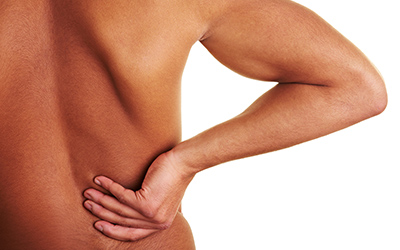 4 out of 5 people suffer with one or more episodes of back pain throughout their life. It is probably the most common condition that we treat.
4 out of 5 people suffer with one or more episodes of back pain throughout their life. It is probably the most common condition that we treat.
The complex design of the lumbar spine provides tremendous strength and flexibility in addition to providing protection for the highly sensitive spinal cord and nerve roots.
The low back consists of 5 moveable vertebrae numbered L1-L5. The bottom lumbar vertebrae (L 5), is joined to the sacrum which is a triangular shaped bone in the pelvis, made up of 5 fused vertebrae. Beneath this is the coccyx which is a small piece of bone that projects out from the very bottom of the spine.
The vertebrae are peculiarly shaped bones which are linked to their adjacent vertebrae by small facet joints. Between each of the vertebrae is a 'disc'. These are made of a tough fibrous outer layer and a softer gel-like centre. The disc acts like a 'shock absorber' and help give the back its flexibility.
Low back conditions that we treat
- Back pain
- Osteoarthritis/wear and tear (Lumbar spondylosis)
- Disc pathologies (slipped/bulging/ruptured degenerative discs)
- Trapped nerves/nerve root pain (Sciatica)
- Scoliosis
- Muscular and ligament strains
- Sacroiliac joint pain/dysfunction
- Ankylosing spondylitis
- Postural related symptoms
- Spondylolisthesis / Pars Interarticularis fractures
- Pregnancy related symptoms
- Fractures (broken bones)
Following surgery
- Micro-discectomy
- Spinal decompression
- Lumbar fusion
- Dynesys stabilisation
- Lumbar laminectomy
- Nerve root injection
- Facet joint injection
This list is not exhaustive; please ring the clinic if you have any queries about other conditions or injuries.
Your condition will be thoroughly assessed by your physiotherapist, who will explain their findings and discuss the proposed treatment plan with you for your agreement.
When treating back problems it is particularly important to try and address the cause of the problem to try to prevent reoccurrence. The clinic also offers workplace advice to aid correct working positions. You may also benefit from our individual Pilates sessions to improve core strength and posture.
For extra information or to book an appointment please call 0114 237 3006 or email info@thephysioclinic.org
Hip, Pelvis and Upper Leg
The hip, pelvis and upper leg is the junction between the trunk/upper body and lower limbs. Normal function in this area is vital for the control, stabilisation and power of the rest of the body.
The hip is described as a 'ball and socket' joint and is one of the largest weight-bearing joints in the body. It is composed of the head of the femur (upper thigh bone) which articulates with a socket in the pelvis.
Major nerves run through the hip area. These include the sciatic nerve at the back of the hip and femoral nerve at the front.
The pelvis is a bony ring including the pubic bone at the front, the hip joints in the groin and the sacro-iliac joints either side of the base of the spine.
There are a number of powerful muscle groups in the area which are responsible for maintaining an up right posture, stabilising the trunk and lower body and providing the power required through the lower limbs for locomotion etc. some of these key muscles are gluteus maximus and medious, the hamstrings, the abductors/adductors of the hip, the quadriceps, the iliacus and psoas major, Ileotibial Band and piriformis.
Hip, pelvis and upper leg conditions that we treat
- Arthritis
- Muscle strains
- Sacroiliac joint pain, dysfunction
- Tendonitis
- Trochanteric Bursitis
- Piriformis syndrome
- Haematomas
- Osteitis pubis
- Femoral Acetabular Impingement
- Snapping hip syndrome (Dancers hip)
- Fractures (broken bones):
Following surgery
- Total and partial hip replacements
- Hip resurfacing
- Inguinal/Gilmore's groin/sportsman's hernia repairs
- Femoral Acetabular Impingement
This list is not exhaustive; please ring the clinic if you have any queries about other conditions or injuries.
Your condition will be thoroughly assessed by your physiotherapist, who will explain their findings and discuss the proposed treatment plan with you for your agreement.
For extra information or to book an appointment please call 0114 237 3006 or email info@thephysioclinic.org
Knee and Lower Leg
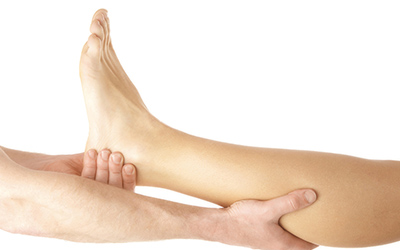 The knee is one of the largest and most complicated joints in the body.
The knee is one of the largest and most complicated joints in the body.
It plays a vital role in holding up your bodyweight and undergoes significant stresses with walking, running, jumping, and twisting. Consequently knee conditions are very common, both from every day use, sports injuries and wear and tear.
The knee joint comprises of the femur (thigh bone), and the tibia (shin bone), and is known as the tibiofemoral Joint. The patella (knee cap), lies in a groove at the lower end of the femur (thigh bone), forming a second joint known as the patellofemoral Joint.
The stability of the knee joint is provided by 4 main ligaments. These are the anterior and posterior cruciate ligaments which cross over in the centre of the joint and two ligaments which stabilise either side of the joint (the medial and lateral collateral ligaments).
Two C shaped wedges of cartilage called the medial and lateral menisci lie between the femur and tibia. Their main function is to act as shock absorbers between the femur and the tibia.
There are also a number of bursae, (fluid-filled sacs), around the knee which help it move smoothly.
There are a number of key mucscle groups around the knee. These are the quadriceps muscles at the front of the thigh, the hamstrings at the back of the thigh and the gastrocnemius & soleus muscles of the calf. Working together these muscles provide strength and balance to the joint.
Knee and lower leg conditions that we treat
- Ligament sprains/injury
- Meniscal (cartilage) tears
- Osteoarthritis (wear and tear)
- Patella tendonitis
- Muscle strains
- Bursitis (Housemaid's Knee/Bakers Cyst)
- Anterior knee pain /Chondromalacia Patella
- Patello-femoral pain syndrome
- Fat pad impingement
- Osgood Schlatters disease
- Iliotibial band (ITB) syndrome
- Sinding-Larssen Johansson syndrome
- Anterior Compartment syndrome
- Shin splints (periostitis/tibial stress syndrome)
- Tibialis posterior insufficiency syndrome
- Gastrocnemious/soleous (calf) strain
- Tibialis posterior insufficiency syndrome
- Fractures (broken bones)
Following surgery
- Arthroscopy
- Cartilage repairs (menisectomies)
- Anterior/Posterior Cruciate repairs
- Osteochondral defects
- Joint replacements (half and total knee replacements)
This list is not exhaustive; please ring the clinic if you have any queries about other conditions or injuries.
Your condition will be thoroughly assessed by your physiotherapist, who will explain their findings and discuss the proposed treatment plan with you for your agreement.
If appropriate you may be referred to our podiatrist for a biomechanical assessment regarding lower limb or foot imbalances.
For extra information or to book an appointment please call 0114 237 3006 or email info@thephysioclinic.org
Ankle and Foot
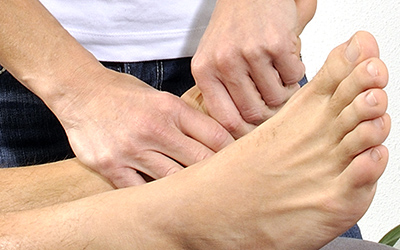 The foot and ankle area is a complex part of the body. It is responsible for the propulsion, balance, and support of the body's weight during many diverse activities, such as standing, walking, running, jumping and twisting.
The foot and ankle area is a complex part of the body. It is responsible for the propulsion, balance, and support of the body's weight during many diverse activities, such as standing, walking, running, jumping and twisting.
The ankle is a large joint made up of three bones. The tibia (shin bone), the fibula (the thin bone next to the tibia) and the talus bone which is in the foot and sits above the heel bone (calcaneous)
The ankle joint allows up-and-down movement of the foot. Below the ankle sits the subtalar joint which allows side-to-side movements.
There are numerous ligaments surrounding the ankle and subtalar joints, strengthening and binding the bones of the leg to each other and to those of the foot.
The foot is an incredible structure comprised of 26 different bones, 33 joints and many muscles, ligaments and nerves. It has to support our full body weight and accommodate the stresses and strains of every day life, uneven surfaces and sporting activities. It has to be able to perform as a shock absorber to accommodate impact forces but also to act as a lever for propulsion.
Ankle and foot conditions that we treat
- Ligament sprains/'twisted ankles'
- Muscle strains
- High ankle/syndesmosis sprains)
- Achilles tendinopathy/tendinitis)
- Dislocations
- Arthritis
- Sever's Disease
- Plantarfasciitiss
- Following fractures: tibia, fibula, calcaneous, talus
Following surgery
- Arthroscopy
- Ankle ligament surgery/reconstruction
- Ankle replacements
- Syndesmosis repairs
- Osteochondral defects
- Pronating feet and other foot imbalances
- Morton's Neuroma
- Bursitis
- Fractures (broken bones): tarsal, metatarsal, phalangea
Following surgery
- Bunion surgery
This list is not exhaustive; please ring the clinic if you have any queries about other conditions or injuries.
Your condition will be thoroughly assessed by your physiotherapist, who will explain their findings and discuss the proposed treatment plan with you for your agreement.
If appropriate you may be referred to our podiatrist for a biomechanical assessment regarding lower limb or foot imbalances.
For extra information or to book an appointment please call 0114 237 3006 or email info@thephysioclinic.org
Sports Injuries
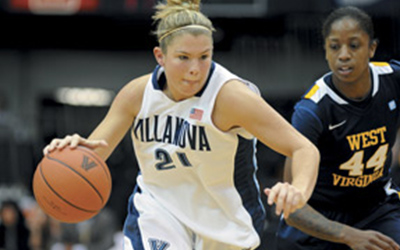 There are many physical, social, and psychological benefits to participating in sporting activity.
There are many physical, social, and psychological benefits to participating in sporting activity.
Playing sport and taking part in regular exercise is good for your health, but can sometimes result in injury.
Some sports injuries are considered traumatic in nature e.g. a bad tackle playing football resulting in knee ligament damage, others may be overuse injuries, which runners are prone to, while others may be degenerative in nature (wear and tear) e.g. the retired golfer with an arthritic knee.
So whether you are a professional athlete or exercise for recreational purposes we aim to get you back 'on track' as soon as possible.
Sports Injuries - Head and Neck conditions
- Disc pathologies (bulging/'slipped'/ruptured/degenerative/discs)
- Referred pain and 'trapped nerves'
- Whiplash injuries
- Muscular strains and tears
- Torticollis
- Facet joint pain
Sports Injuries - Shoulder and upper arm conditions
- Sub-acromial impingement
- Rotator Cuff tears/tendonitis
- Muscle strains and tears
- Shoulder subluxation/dislocation & instabilities
- Labral pathologies (Bankart, SLAP tears)
- Acromio-clavicular/sterno-clavicular joint injury
- 'Trapped Nerves'
- Haematomas
- Following dislocations/surgery/fractures
Sports Injuries - Elbow and forearm conditions
- Tennis and Golfers elbow
- Ligament sprains
- Muscle strains and tears
- Bursitis
- 'Trapped nerves'
- Acromio-clavicular/sterno-clavicular joint injury
- Following dislocations/surgery/fractures
Sports Injuries - Wrist, hand and finger conditions
- Tenosynovitis
- Muscle and tendon strains
- Ligament sprains (skiers thumb)
- Wrist tendonitis
- Following dislocations/surgery/fractures
Sports Injuries - Lower back conditions
- Back Pain
- Muscular strains and tears
- Disc pathologies (bulging/'slipped'/ruptured/degenerative/discs)
- Nerve root pain ('trapped nerves'/Sciatica)
- Facet joint pain
- Sacroiliac joint pain/dysfunction
- Spondylolisthesis
- Following fractures/surgery
Sports Injuries - Hip, pelvis and upper leg conditions
- Sacroiliac joint pain/dysfunction
- Piriformis syndrome
- Bursitis (Trochanteric, Hamstrings, Gluteal, Iliopsoas)
- Labral tears
- Tendinitis (Hamstrings, Quadriceps, Iliopsoas, Gluteal)
- Muscle strains and tears
- Osteitis pubis
- Snapping hip syndromes (Dancers hip)
- Inguinal, Gimore's/Sportman's hernia
- Haematomas
- Following surgery/fractures
Sports Injuries - Knee and lower leg conditions
- Ligament sprains/reconstructions
- Tendinitis
- Muscle strain and tears
- Bursitis (Housemaid's Knee/Bakers Cyst)
- Fat pad impingement
- Patello-femoral pain syndrome
- Anterior knee pain
- Osgood-Schlatters
- 'Shin splints'
- Iliotibial band syndromes
- Compartment syndromes
- Following dislocations/surgery/fractures
Sports Injuries - Ankle conditions
- Ligament sprains/twisted ankles
- Muscle strain and tears
- Achilles tendinitis/tendinopathy
- Tibialis posterior tendinopathy
- Bursitis
- Following surgery/fractures/dislocations
Sports Injuries - Foot conditions
- Foot imbalances (over pronation etc)
- Plantarfasciitis
- Bursitis / neuroma
- Following surgery/fractures/dislocations
In addition you may be advised on training techniques/schedules, warm up/down, stretching, and the retraining of muscles to strengthen and maintain balance.
For extra information or to book an appointment please call 0114 237 3006 or email info@thephysioclinic.org
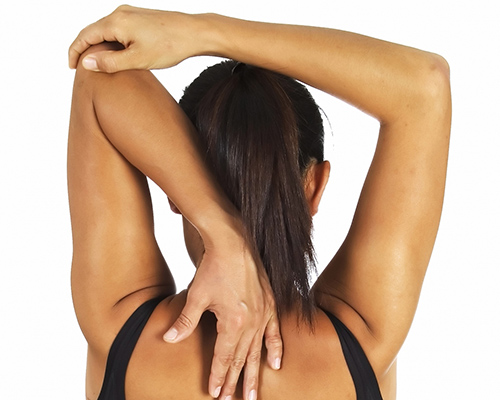
What we treat
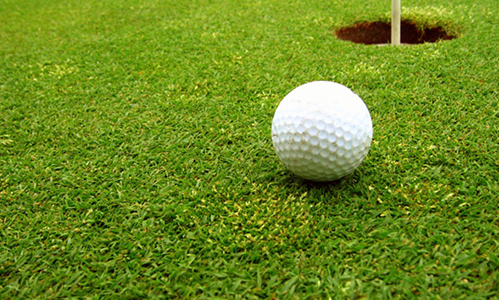
Sports Injuries
Playing sport and taking part in regular exercise has many benefits including being good for your health, but can sometimes result in injury.
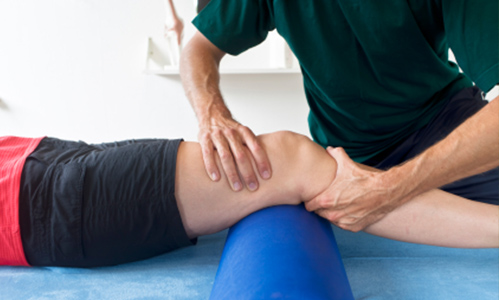
Lower Leg Injuries
The lower leg plays a vital role in holding up your bodyweight and undergoes significant stresses with walking, running, jumping, and twisting.

